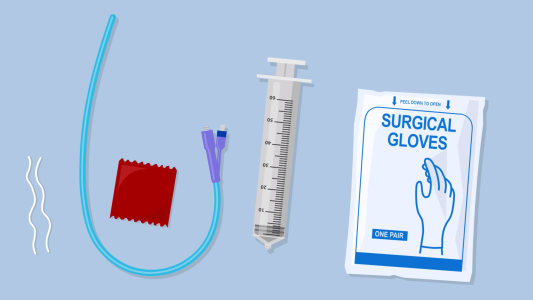The United States is facing its worst measles epidemic in nearly three decades. According to the CDC, over 1,000 people have already been infected with the extremely contagious (and occasionally deadly) virus in just the first half of 2019—more than in any full year since 1992.
The CDC reports there are 10 ongoing outbreaks across the country, with confirmed cases in 26 states.
Despite the fact that measles was officially eliminated from inside the US in 2000, the disease is periodically caught by people traveling overseas, and because it is so contagious, it can spread rapidly when they return home.
Up to 90% of unvaccinated people who come into contact with it will catch the disease, and they can spread it for up to four days before they feel ill.
There is a highly effective and widely used vaccine against measles (usually combined with vaccines against mumps and rubella into the “MMR” shot), and widespread immunity will stop an epidemic in its tracks, by reducing the rate of transmission, much like a rainy forest tamping down on wildfires.
The vast majority of people in the US get vaccinated, which is why the disease went from being nearly universal (prior to the vaccine, almost every child got measles, with 3-4 million infections each year) to almost nonexistent.
However, throughout the country, there are clusters of unvaccinated people. These clusters can be found among small religious groups, such as in Amish and Orthodox Jewish communities, but they are also increasingly common in schools in wealthy urban areas, where mistaken fears about autism have led some parents to refuse or delay vaccination.
States that have weakened public school admissions requirements, such as Texas, have seen rising numbers of parents opting out of vaccination for non-medical reasons.
It only takes a single person returning from a country with endemic measles to spark an outbreak in these areas. Once it takes off, it can be hard to contain. With a vaccine that is 97% effective, if 100 vaccinated people are exposed, three can catch it and carry it a little further—while 90 out of 100 unvaccinated will.
Rising fears about “vaccine hesitancy” led the World Health Organization to name it one of the world’s top 10 threats to global health in 2019. Despite being a small fraction of the population, the CDC reports that the unvaccinated and under-vaccinated are a majority of new measles cases in the US.
But while there is good reason for concern about increasing vaccine hesitancy, it’s not clear how much of the new epidemic it explains at this point. There is evidence that some parents are delaying vaccination, but overall, US vaccination rates are high, close to the 95% target the CDC has set to ensure diseases can’t spread.
Vaccine uptake by new parents also does not seem to have changed much. According to CDC data, in 2017, 92% of children aged 19-35 months received at least one dose of the MMR vaccine (the CDC target for this age group is 90%), almost exactly the average over the last twenty years.
This is in stark contrast to the United Kingdom, where the now thoroughly discredited study linking the MMR vaccine to autism caused vaccination rates to crash after it was published in 1998.
Measles, unsurprisingly, roared back in the UK, and it took almost 15 years for the country’s immunization rates to recover.
Is Vaccine Effectiveness Declining?
If changes in overall vaccination rates don’t fully explain the outbreak, what does? One concern is that the vaccine’s effectiveness could be declining or wearing off.
A study in 2007 showed that 5% of kids who got both doses of MMR had low antibodies for measles a decade later. Another study in 2015 found that the antibodies for measles, rubella, and mumps had waned significantly over two decades, gradually reducing the protection it offers.
Scientists have suggested that the recent spike in mumps in the US is likely partly explained by the vaccine’s defenses wearing off.
This has happened before. In 1989, a large measles outbreak, primarily affecting vaccinated school-age children, showed that a single dose wasn’t cutting it anymore, and the CDC recommended a booster.
As the booster shot rolled out, the epidemic was extinguished, and measles was soon fully eliminated in 2000.
Another possibility is that the disease could be evolving to get around the immune defenses created by the vaccine. Unless a disease is totally eradicated from the planet, like smallpox was in 1979, it’s still out there, and natural selection is still pressuring it to adapt and spread.
Given enough time, its genetic code can drift and change enough that our immune defenses won’t always see it as the same threat the vaccine primed us against. This process happens much faster in a virus that mutates frequently, like the flu, which is why new flu shots have to be created every year.
Like antibiotics and drug-resistant bacteria, people are locked in an arms race with diseases: they are constantly trying to hack our immune system, we continue updating our vaccines, and the diseases evolve new ways to try to sneak past them.
The good news is that, so far, the measles virus doesn’t seem to be evolving very much.
The Bordetella bacteria that causes pertussis (also known as whooping cough), on the other hand, may well be evolving resistance to its vaccine — possibly explaining the steady resurgence of the disease.
Because the unvaccinated have almost no defense against the bacteria, they still make up a hugely disproportionate share of whooping cough cases. But in 2017, according to the CDC, most new cases of pertussis (unlike measles) likely involved people who had been vaccinated.
In the late 1980s, concerns about side-effects from the “whole-cell” pertussis shot (usually, rashes, swelling, and pain at the injection site) caused health authorities in the US to recommend switching to the “acellular” version of the vaccine (which did not use the bacteria’s cell wall).
Rolled out throughout the 1990s, the new version had fewer side-effects, but it also provided weaker immunity for a shorter period of time.
Four doses of the acellular version are typically given to young children, and another booster was recommended for older kids and adults in 2005. But it hasn’t been enough, and whooping cough has surged in recent years.
Given the serious threat posed by whooping cough to infants, the CDC now recommends pregnant mothers get a booster around 27 weeks, as well.
A 2018 study suggests that not only is the newer vaccine less protective, the Bordetella DNA itself is evolving, although scientists don’t yet understand what the genetic changes mean.
One possible adaptation, spotted in Israel in 2000, allows some vaccinated kids to carry the infection while lacking symptoms — meaning the bacteria could lay low in vaccinated individuals and only cause disease when it jumps to someone with no defenses.
The weaker acellular vaccine may also be playing a role in its evolution. Much like failing to take a full course of antibiotics allows bacteria to develop resistance to the drugs, weaker immunity in a population allows infections to continue and spread, giving the disease more opportunities to adapt to our immune defenses.
This is one major reason why high vaccination rates are important to defeating disease. When there are only a few active infections out there, the opportunities to evolve and adapt are more limited. When there are tens or hundreds of thousands of new infections, the disease gets an upper hand in the arms race against immunity.
Unfortunately, vaccination rates for young children with the “DTaP” vaccine (which covers diphtheria and tetanus, as well as acellular pertussis) are stagnant and below target, and have even declined a couple percent as whooping cough has worsened.
The Options
What should we do about all this? The first option is simple: boost vaccine coverage. Vaccines provide a ton of protection for individuals, and the more people who are vaccinated, the harder is for the disease to spread and expose anyone in the first place.
Boosting vaccination rates a few percent, especially in vulnerable populations (like pregnant mothers, those in rural areas, and insular religious communities), could go a long way to preventing these outbreaks.
But there are limits to how much we can reasonably expect from improving coverage. Vaccination rates are already very high, and they haven’t budged much in decades. Getting some of those last few people to the doctor, on schedule, will simply be difficult for all sorts of reasons, whether they are hesitant of vaccines or not.
For the resurgent measles and mumps issue, a plausible option is another booster shot for MMR, as was done in 1989. For whooping cough, a new version of the whole-cell vaccine, with fewer side effects, could boost protection without requiring more doctors’ visits.
In the long term, some cutting-edge research is exploring how to stimulate immunity without a vaccine, using the new gene-editing technology known as CRISPR.
Will CRISPR Work Where Vaccines Don’t?
Dr. Justin Taylor, a scientist at the Fred Hutchinson Cancer Research Center, has proposed a technique that would simply skip the vaccine altogether by directly instructing the immune system what disease to target.
Vaccines work by stimulating the body’s natural defenses to produce antibodies that destroy a pathogen. The vaccine tricks the immune “B cells” into thinking it’s a pathogen, and the B cells respond by producing an army of antibodies, designed to search and destroy that specific infection. When the real disease shows up, the immune system is already prepared for it.
The trouble with vaccines is that creating new ones is really hard.
For many diseases, building just the right antigen that triggers the immune system to recognize the real thing can be very complicated, and doing it in a way that provides long lasting immunity is even trickier. Scientists have been working for decades to develop vaccines against diseases like HIV and Epstein-Barr, with little success.
Taylor proposes cutting out the vaccine middleman and going straight to the B cells. If you could use CRISPR to modify some B cells’ DNA, you could directly tell the immune system: “this is the bad thing, go forth, make antibodies, and destroy it.” (You may have heard about a similar technique called “CAR T” for fighting cancer.)
In a mouse experiment, at least, this theory worked beautifully, protecting the mice against respiratory syncytial virus (RSV), a major cause of infant respiratory infections. According to a report in STAT News,
When the scientists took mouse B cells that had been CRISPR’d to synthesize antibodies against respiratory syncytial virus and injected them into immune-compromised mice, the recipients soon had anti-RSV antibodies in their blood: When they were infected with RSV, the virus was undetectable in their lungs. The transplanted, CRISPR’d B cells had given them immunity to it, just as a successful vaccine does.
Using CRISPR to edit B cells could produce “immunity against pathogens for which traditional vaccination has failed,” Taylor and his colleagues wrote in their preprint, which they’ve submitted to a journal for peer review.
But Taylor doesn’t expect this technique to replace traditional vaccines anytime soon, if ever, because vaccines are incredibly cheap to mass produce and distribute.
Vaccines don’t have to be individually tailored to each person, and (for now, anyway) there are no “universal donor” B cells that could be used to provide immunity to anyone. Every patient would need to have the cells specially designed for them.
But he also told STAT that he “believes it’s possible to engineer B cells to defeat that antigenic drift” — meaning, the evolution of diseases around the immune system’s defenses.
In an email to Freethink, Taylor also said that he thinks it’s plausible that CRISPR’ing immune cells could play a role, in the long run, in bolstering immunity against diseases where traditional vaccines exist but may eventually decline in efficacy.
“The platforms that my group and others have begun to develop are very flexible,” he said, “in that they can be applied to any infection in which the genes encoding a protective antibody have been sequenced.”
The key, Taylor says, will be making it more available and affordable, but he’s optimistic there.
“While our current system may be too expensive for high use, I think there will be a lot of innovation in this area that will bring the costs down considerably.”
Depending on how difficult it is for traditional vaccines to keep up in the arms race against their diseases, in the long term, CRISPR may be at least a fallback option for diseases that outwit us.
In the fight against disease, vaccines have been one of humanity’s surest and most reliable weapons. It’s possible that CRISPR will be the next.





